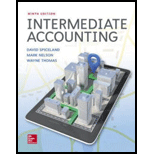
Concept explainers
Current –noncurrent classification of debt
• LO13–1, LO13–4
The
a. 11% bonds with a face amount of $40 million were issued for $40 million on October 31, 2009. The bonds mature on October 31, 2029. Bondholders have the option of calling (demanding payment on) the bonds on October 31, 2019, at a redemption price of $40 million. Market conditions are such that the call is not expected to be exercised.
b. Management intended to refinance $6 million of its 10% notes that mature in May 2019. In early March, prior to the actual issuance of the 2018 financial statements, Nevada Harvester negotiated a line of credit with a commercial bank for up to $5 million any time during 2019. Any borrowings will mature two years from the date of borrowing.
c. Noncallable 12% bonds with a face amount of $20 million were issued for $20 million on September 30, 1996. The bonds mature on September 30, 2019. Sufficient cash is expected to be available to retire the bonds at maturity.
d. A $12 million 9% bank loan is payable on October 31, 2024. The bank has the right to demand payment after any fiscal year-end in which Nevada Harvester’s ratio of current assets to current liabilities falls below a contractual minimum of 1.7 to 1 and remains so for six months. That ratio was 1.45 on December 31, 2018, due primarily to an intentional temporary decline in inventory levels. Normal inventory levels will be reestablished during the first quarter of 2019.
Required:
1. Determine the amount that can be excluded from classification as a current liability (that is, reported as a noncurrent liability) for each. Explain the reasoning behind your classifications.
2. Prepare the liability section of a classified balance sheet and any necessary note disclosure for Nevada Harvester at December 31, 2018. Accounts payable and accruals are $22 million.
Want to see the full answer?
Check out a sample textbook solution
Chapter 13 Solutions
Intermediate Accounting
- I need help finding the accurate solution to this general accounting problem with valid methods.arrow_forwardI am looking for help with this general accounting question using proper accounting standards.arrow_forwardCan you solve this financial accounting problem using appropriate financial principles?arrow_forward
 Cornerstones of Financial AccountingAccountingISBN:9781337690881Author:Jay Rich, Jeff JonesPublisher:Cengage Learning
Cornerstones of Financial AccountingAccountingISBN:9781337690881Author:Jay Rich, Jeff JonesPublisher:Cengage Learning Intermediate Accounting: Reporting And AnalysisAccountingISBN:9781337788281Author:James M. Wahlen, Jefferson P. Jones, Donald PagachPublisher:Cengage Learning
Intermediate Accounting: Reporting And AnalysisAccountingISBN:9781337788281Author:James M. Wahlen, Jefferson P. Jones, Donald PagachPublisher:Cengage Learning Financial Accounting: The Impact on Decision Make...AccountingISBN:9781305654174Author:Gary A. Porter, Curtis L. NortonPublisher:Cengage Learning
Financial Accounting: The Impact on Decision Make...AccountingISBN:9781305654174Author:Gary A. Porter, Curtis L. NortonPublisher:Cengage Learning


